Luca Pacioli (1445-1517)
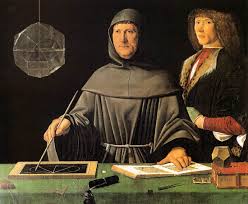
In his Divina proportione (On Divine Proportion) wrote about the golden section also called the golden mean or the divine proportion:
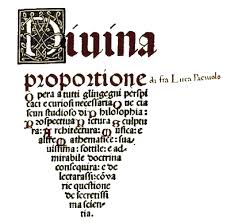
The line AB is divided at point C so that the ratio of the two parts, the smaller BC to the larger CA is the same as the ratio of the larger part AC to the whole AB.
This gives two ratios, AC:AB which is also BC:AC and is 0.618... which we call phi (beginning with a small p). The other ratio is AB:AC = AC:CB = 1/phi= 1.618... or Phi (note the capital P). Both of these are variously called the golden number or golden ratio, golden section, golden mean or the divine proportion.
Pacioli's work influenced Leonardo da Vinci (1452-1519) and Albrecht Durer (1471-1528) and is seen in some of the work of Georges Seurat, Paul Signac and Mondrian, for instance.
Many books on oil painting and water colour in your local library will point out that it is better to position objects not in the centre of the picture but to one side or "about one-third" of the way across, and to use lines which divide the picture into thirds. This seems to make the picture design more pleasing to the eye and relies again on the idea of the golden section being "ideal".

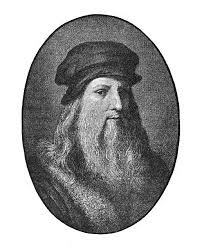
Leonardo's Art (1452 - 1519)
The Uffizi Gallery's Web site in Florence, Italy, has a virtual room of some of Leonardo da Vinci's paintings and drawings. Let's analyse the following two of Leonardo Da Vinci's paintings:
The Annunciation

is a picture that looks like it is in a frame of 1:sqrt(5) shape (a root-5 rectangle). Print it and measure it - is it a root-5 rectangle? Divide it into a square on the left and another on the right. (If it is a root-5 rectangle, these lines mark out two golden-section rectangles as the parts remaining after a square has been removed). Also mark in the lines across the picture which are 0·618 of the way up and 0·618 of the way down it. Also mark in the vertical lines which are 0·618 of the way along from both ends. You will see that these lines mark out significant parts of the picture or go through important objects. You can then try marking lines that divide these parts into their golden sections too.
Madonna with Child and Saints

is in a square frame. Look at the golden section lines (0·618 of the way down and up the frame and 0·618 of the way across from the left and from the right) and see if these lines mark out significant parts of the picture. Do other sub-divisions look like further golden sections?
Take a look:

Albrecht Durer (1471-1528)

Observe the following Durer's drawings and see if you find the Golden Ratio:
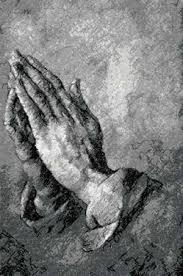


Modern Art
Graham Sutherland's Tapestry in Coventry Cathedral


Graham Sutherland's (1903-1980) huge tapestry of Christ The King behind the altar in Coventry Cathedral here in a picture taken by Rob Orland.
It seems to have been designed with some clear golden sections as I've shown on Rob's picture:
The bottom the the girdle (waist-band) is also at a golden section point for the whole figure from the top of the head to the soles of the feet, shown by purple arrows.
Since this is also the position of the navel in the human body, this indicates the figure is standing.
The work of modern artists using the Golden Section
Fibonacci Numbers in Quilt design.
Patricia Bennetts and Mary Miller
 Their two designs are based on the pattern in the middle where the strips in the lower half are of widths 1, 2, 3, 5, 8 and 13 in brown which are alternated with lighter strips of the same widths but in decreasing order.
Their two designs are based on the pattern in the middle where the strips in the lower half are of widths 1, 2, 3, 5, 8 and 13 in brown which are alternated with lighter strips of the same widths but in decreasing order.
 |
Woolly Thoughts is Steve Plummer and Pat Ashforth's web site with many maths inspired knitting and crochet projects, including designs based on Fibonacci numbers, the golden spiral, pythagorean triangles, flexagons and much much more. They have worked for many years in schools giving a new twist to mathematics with their hands-on approach to design using school maths. An excellent resource for teachers who want to get students involved in maths in a new way and also for mathematicians interested in knitting and crochet. |
 |
Billie Ruth Sudduth is a North American artist specialising in basket work that is now internationally known. Her designs are based on the Fibonacci Numbers and the golden section - see her web page JABOBs (Just A Bunch Of Baskets). Mathematics Teaching in the Middle School has a good online introduction to her work (January 1999). |
 |
Kees van Prooijen of California has used a similar series to the Fibonacci series - one made from adding the previous three terms, as a basis for his art. |
Where's the Golden Ratio?
Mondrian:
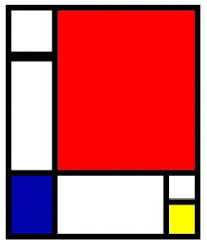
Tina Westerkamp>

MATH and ART
Comments (0)
You don't have permission to comment on this page.